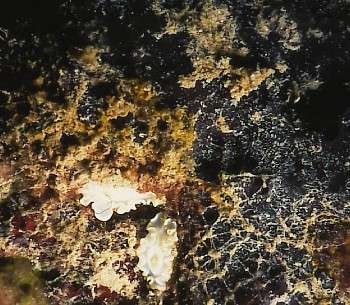
Chemical ecology
PHOTO
Two Glossodoris pallida and their food sponge, Cacospongia sp. Vanuatu. 1995. PHOTO: J.K. Stenhouse
Without a protective shell, sea slugs have had develop other defences against predation. These include cryptic colouration or camouflage and behavioural modifications such as only being active at night. Another major development has been the use of chemicals to make them posionous or at least extremely distasteful to potential predators. Opisthobranchs have become a target for research by marine products chemists and gradually we are discovering just the widespread and complex ways chemicals are used by sea slugs. Many store these chemicals in special glands in their skin. What is starting to fascinate chemists and physiologists is the many different ways the molecules are produced. In some cases the chemical molecules [often called metabolites] are removed from their food and stored unchanged by the opisthobranch. In other cases the molecules from the food are modified by the opisthobranch, and in some cases the opisthobranch makes new molecules itself. Usually, each species of opisthobranch has very specialised food requirements and often its defensive molecules are uniquely different from closely related species.
See below for relevant messages.
See Defensive Glands Page for further references and messages.
The above photo illustrates a good example of the role chemicals play in the life of these animals. The two nudibranchs are the chromodorid Glossodoris pallida on a large colony of a grey-black sponge which is almost certainly their food, the dictyoceratid sponge Cacospongia sp. A study by Avila & Paul (1997) on this species shows that, like other chromodorids, G. pallida is storing antifeedant chemicals, which are derived from its food, in particular parts of its body. They also showed that these chemicals do indeed deter fish.
In particular they found sponge-derived terpenoid compounds concentrated around the mantle border and in the mucous secretions of the mantle. They found that at their natural concentrations these chemicals deterred some crabs and reef fishes from feeding. They also found that animals which had had their mantle borders removed were much more likely to be eaten than those in which the mantle was intact. This is a very significant advance in our understanding of the biology of these fascinating animals.
References:
• Avila, C. (1995): Natural products of opisthobranch molluscs: a biological review. Oceanography and Marine Biology: an Annual Review, 33: 487-559
• Avila, C. & Paul, V.J. (1997) Chemical ecology of the nudibranch Glossodoris pallida: is the location of diet-derived metabolites important for defense?. Marine Ecology Progress Series, 150: 171-180.
• Cimino, G., Fontana, A. & Gavagnin, M. (1999) Marine Opisthobranch Molluscs: Chemistry and Ecology in Sacoglossans and Dorids. Current Organic Chemistry, 3(4): 327-372.
• Faulkner, D.J., Ghiselin, M.T. (1983) Chemical defence and evolutionary ecology of dorid nudibranchs and some other opisthobranch gastropods. Mar. Ecol. Prog. Ser. 13: 295-301.
• Karuso, P. (1987) Chemical ecology of the nudibranchs, pp. 31-60. In: Scheuer, P.J. (Ed.), Bioorganic marine chemistry, vol. 1: vii + 185 pp. Springer-Verlag, Berlin.
Rudman, W.B., 2004 (July 27) Chemical ecology. [In] Sea Slug Forum. Australian Museum, Sydney. Available from http://www.seaslugforum.net/factsheet/chemecol
Related messages
-
Re: Diterpenes - what are they?
From: Edwin Cruz-Rivera, July 27, 2002 -
Diterpenes - what are they?
From: Virginie Fruh, July 3, 2002 -
Medical uses
From: Alexander Taborda Marin, May 31, 2002 -
Chemical information about Sea Slugs
From: Arnaud Parenty, March 15, 2001 -
Medical uses
From: Jacob Hall, May 18, 1998
